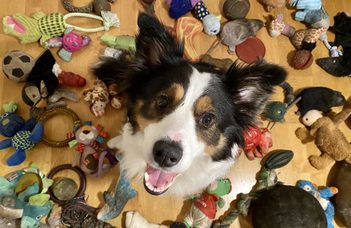A special dog: Whisky’s world

Whisky’s world: a special dog revealed that she spontaneously parts objects in categories
Whisky is a female Border collie, she is now 6 years old and, like many other dogs, she shares her life with her owners, living in a human family.
Like many other dogs, Whisky loves to play with toys with her owners. But, unlike most other dogs, she has learned the name of all her toys … and these are many! Her owner reports that now she knows the name of around 90 toys, but when the scientists from the Department of Ethology at Eötvös Loránd University first found out about her, she knew the name of 59 toys.
“At first it was hard for me to believe that a dog learned the name of so many toys, but after several days of rigorous testing, I had to change my mind” says lead researcher Claudia Fugazza.
To exclude that Whisky would rely on visual cues such as pointing or looking at the correct toy, the scientists placed the toys out of view from the owner. This way he could not guide Whisky’s choice of the correct toy by using visual cues.
“We noticed that, among her toys, Whisky had several exemplars belonging to one of 4 categories: she had 10 different balls, 7 different rings, 4 different ropes and 4 different Frisbees” reports Fugazza. Each of those toys had its proper name that was composed by an adjective and the word referring to the category (e.g. the “Green rope”); They were not simply called “rope”, “ring” etc. “This provided us a rare opportunity: testing whether a dog had spontaneously formed some mental categories, simply by being exposed to their exemplars. Pretty much like a human child would do”, continues the researcher.
Ádám Miklósi, co-author and head of the Department, explains: “Most studies on the ability of non-human animals to categorize are conducted after the subjects are extensively trained to recognize categories with a given set of exemplars. Only after reaching the predetermined criterion, they are tested on their ability to categorize novel items belonging to those learned categories.
If Whisky had learned some categories, this had happened spontaneously, during playful interactions with her owners. This gave the scientists the unique opportunity to test spontaneous categorization skills in a dog.
The new study, just published in Scientific Reports and funded by the National Brain Research Program (2017-1.2.1-NKP-2017-00002), shows that Whisky was able to categorize novel objects belonging to one of the 4 categories of rings, balls, Frisbees and ropes, even if she had never seen those novel exemplars before the test.
In the tests, Whisky was requested to choose, e.g., “a rope” (“Bring me a rope!”) among a set of 4 novel toys, each of which belonging to one of the 4 categories.
Whisky was able to choose the novel toy belonging to the correct category above chance and her performance was even more accurate when, before the tests, she was allowed to play shortly with each of the new toys with her owner, who was asked not to name the toy during play.
“This suggests that, although Whisky relied on the visual features of the toys (e.g., their shape), experiencing the function helped her to make a choice. For example, how to play with them or the way they move”, explains Fugazza.
“The most innovative feature of this study is that Whisky’s achievements mirror human capacities more closely than typical animal studies in two key factors: the lack of specific training for categorization prior to the tests and the use of words to indicate the categories” points out Miklósi. In some sense Whisky’s performance seem to be similar to that of young babies learning their first set of words.
“Since this study was conducted on one subject and dogs with vocabulary knowledge are extremely rare, this capacity should not be automatically extended to all the dogs”, warns Miklósi. “However, the results do reveal that spontaneous categorization in absence of specific training is not a mental skill that is present only in humans”, he concludes.
Link to the published paper, including video about the methods:
https://www.nature.com/articles/s41598-020-59965-6
Web page: https://ethology.elte.hu/Family_Dog_Project
.jpg)
Whisky with some of her toys, with her owners and the researcher Claudia Fugazza (photo by Claudia Fugazza)

Whisky is playing with a toy with the researcher after the tests (photo: Claudia Fugazza)

Whisky listens to her owner as he asks to search for a named toy (photo: Claudia Fugazza)

Whisky and her owner (photo by Tommy Rasamanickam)

